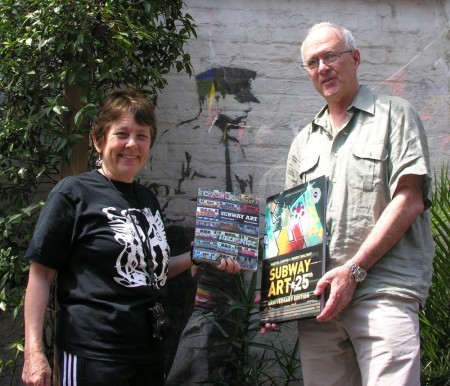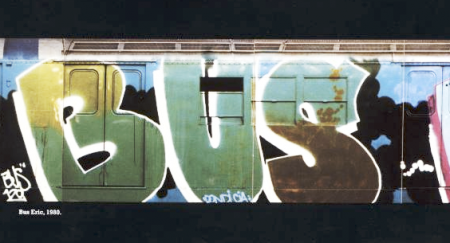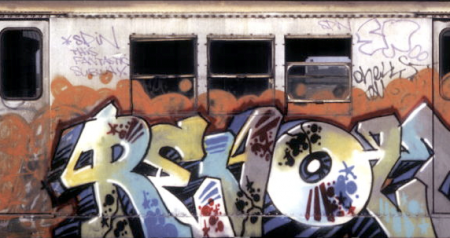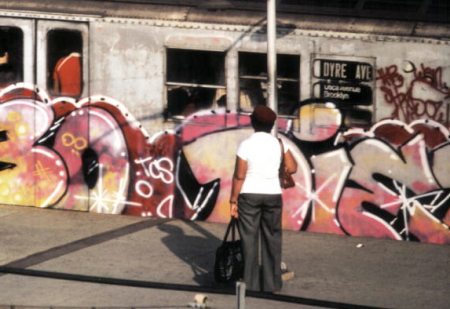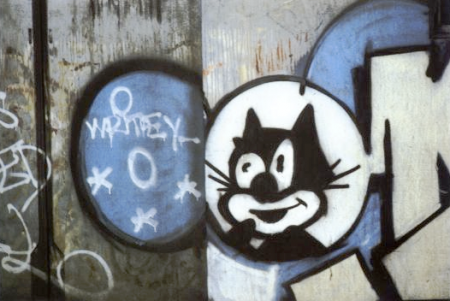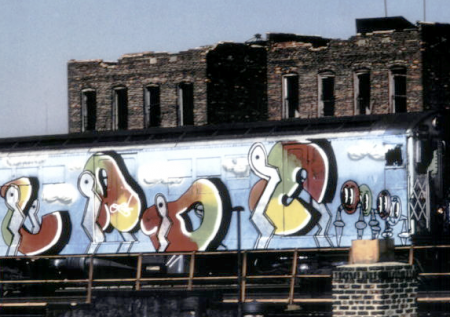AM had the pleasure of interviewing Henry Chalfant and Martha Cooper as they celebrated the launch of their amazing book “Subway Art: 25th Anniversary” at Black Rat Press (covered).  Despite an initial print run of just a few thousand back in 1984, “Subway Art” has become a true phenomenon with countless reprints that have inspired thousands of artists and fans around the world. Check out the interview and get a chance to win a signed copy of “Subway Art: 25th Anniversary” after the jump.
Arrested Motion (AM): How and when did each of you get involved in documenting graffiti and working together on “Subway Art”?
Henry Chalfant (HC): Some time around 1976 I started to take pictures of graffiti on the trains. I’d be living in New York since ’73 and saw them developing and thought they were amazing. I wasn’t a photographer – I was an sculptor – but I had a camera and I started taking sequence shots of sections of the train and splicing them together and it worked well for me to get a good, close up image of the art. It interested me at a time when I was bored – I was getting stir crazy in my studio and I loved the aesthetics of this new style of calligraphy. It was really amazing and erupting from below and pieces wouldn’t last for long getting buffed or weathered or written over. I was hoping one day I’d meet somebody who did graffiti but it took years – they were very cagey. I remember I met a guy who said he knew a writer called Ree so I called Ree up and he said he’d meet me at a certain time at a subway station but of course he didn’t. I only met him 25 years later and he said he didn’t trust me – after all I was twice their age, caucasian and not the type of person they’re used to dealing unless a social worker or police. But by ’79 I had a basic collection together so when I did finally meet the writers I had all this stuff that I could show them and they were accepting at that point.
AM: Was the wider world paying attention at that time?
HC: There were murmurs of interest from the outside world even in ’73 when there was the Razor Gallery show in Soho by UGA – United Graffiti Artists – who were a youth collective collected together the graffiti artists of the time and put on the show. There was an article in New York magazine and a book by John Naar and Mervyn Kurlansky and Norman Mailer wrote the introduction but after the show there was nothing for years. Then in ’79 Lee did a spectacular handball court in the lower east side and it was noticed by an art dealer in Italy and he took Lee and a guy called Fred who arranged things to Rome and they did a show so there was beginning to be more interest around that time. Then I had a show in 1980 at the OK Harris Gallery on West Broadway of 20 of my photos for a week and that really clicked in both with writers who really embraced it as well as art collectors.
Martha Cooper (MC): And that’s where we met as I’d heard about the show and came and introduced myself. I was working as a photojournalist and unlike Henry I didn’t register the art of graffiti. I didn’t read it and couldn’t understand it but I was doing a personal documentary project on the lower East Side photographing kids doing creative things – pictures of kids building go-karts, jumping off fire escapes and those sort of things. And one day, one of the boys I’d photographed before with a pigeon coop said to me why don’t you take pictures of graffiti and showed me his little sketch book – his name was HE3 and that was when I first heard about the use of nicknames. Immediately I also saw he was a designer and when I expressed interest he said that he knew a ‘King’. So. unlike Henry, I managed to meet writers straight away and me and HE3 drove to East New York and knocked on what turned out to be Dondi’s door. When I introduced myself he said “Oh – Martha Cooper” and opened his more lavish black book and inside the cover he had one of my photos he had clipped out of the New York Post so he knew me which was great.! So I met him in 1978 and interviewed him a while later and started looking at the trains which I hadn’t really noticed before though there really weren’t many out there at any one time that were in a fresh state and hadn’t been buffed. I was fascinated at the lengths the writers would go to to do a piece – stealing the paint, designing the piece, preparing the layout, getting into the yard and all of that.
I also really wanted to capture the backgrounds as well as the trains so Henry and I worked separately and had different interests but our styles really complimented each other. We’d both tried to get books published but nothing was happening – so we pooled resources and our styles really worked together and we’d find some initial interest from the odd editor but it wouldn’t go further – particularly in New York especially when you said the word ‘graffiti’. So we went the Frankfurt book fair and met Thames and Hudson in 82 and they were immediately interested and it eventually got published in the UK and the US edition became the foreign edition – which doesn’t mean much to anyone except us as the royalties on the foreign edition are much less than on the original edition though we’re not complaining! Also if people really want to know about the history of graffiti then the first edition of Subway Art is more like a primer with information about graffiti culture while the Anniversary Edition is more an art photography book that really boosts the images – some of which were taken by the writers such as Dondi and Blade themselves. The writers love to be able to see the new details in the larger format. We’re still in touch with a lot of them and some we’ve never even met before have been turning up to the more recent events so that’s fun.
AM: How was the initial publication received?
MC: Well the first thing that happened was the the covers fell off so they trashed the original edition.
HC: So that meant delay and we were worried somebody else was going to do something similar though not as good and get published before us. So it was a slow process and there was no launch or anything though we were happy to get it published.
AM: When did you feel like the book had really taken off?
MC: For me, only recently when somebody put me on the internet and I looked at the artcrimes website or one of the early Zines. I was out the scene for about 20 years though have jumped right back in!
HC: I got inklings of it in 85 because I started getting mail from california, europe, australia and they send a little photo saying “Thank you for your book – its inspired us”.
AM: How do you feel about graffiti moving from the street to the galleries and ultimately to collector’s homes?
MC: For me, I’m not interested in photographing that but I think artists should be able to make money from the art and I’m really happy for them if they can make a living as an artist although I’ve not really followed it personally.
HC: Me too, its never as dynamic or exciting as the original culture when it was on the trains and it was a live phenomenom. The trains were this arterial thing that became a medium that really created communities. If you think of the gang era which preceded this era graffiti just crossed all that creating a community of graffiti writers. And now its the internet, magazine, forum and all over with people painting from city to city which is exciting but I don’t feel a compulsion to document it – they’re taking good pictures themselves.
AM: Where has life taken you since “Subway Art”?
MC: I’ve done a lot of work that has nothing to do with graffiti and have been working as a freelance photographer on various projects. I also work for a folklore organisation documenting all kinds of community things in New York city – you can check out its website at www.citylore.org. I feel like i should have done more about the women involved in graffiti at the time and to rectify that I did a book called We B Girlz which isn’t graffiti but includes some artists such as Asia-1 and I regret that I didn’t try harder to find and feature them as it was predominantly the male writers that I met. There’s also a graffiti artist called 2 Fly who doesn’t do much illegal graffiti but I try to support her work and in the present generation there are way more women involved. I’ve also been documenting street stickers – rather than looking at the big production pieces I’ve been looking at the more subversive hand drawn stickers you can see in my book Going Postal. I’m currently doing another street project photographing in Baltimore – my home town which is going through a difficult drug infested time but very interesting. Its about street culture and last weekend there was a huge community father’s day block party – unnanounced, nothing for sale and not official but the whole block was there with 4 or 5 generations out on the street and I really enjoy photographing that sort of stuff.
HC: Since that time there was the film Style Wars – Tony Silver was the film maker and I played the role of the anthropologist introducing him to the culture. It was my first exposure to film and I wanted to do more after that. So I began to do video as video was coming in by the mid ’80s so I did a couple of hip hop related things – one of them is called All City and then in the mid to late eighties I met Rita Fecher who had a real amazing archive relating to teenage gangs from the 70s – newspaper articles, writings, photos and things like that so Rita and I made a documentary called Flyin’ Cut Sleeves with some old footage Rita had shot in the early 70s. Then I tried to produce some Puerto Rican rappers which was a fiasco but took up about 2 years of my time! The most successful thing I’ve done as a director was a project called From Mambo to Hip Hop which came out about 3 years ago which is about latin music and the Bronx and dance. And I’m trying to finish all kinds of loose ends including digitising all my train photos – to date there are around 600. I want to get them all out once and for all on a DVD and I’ve been interviewing dozens of graffiti writers from that era about their memories and how they got into it and the whole crew structure – alliances and enemies – and how that era impacted on who they are now. So that will be a DVD set with all this material on it.
AM: Martha, how have you found recent collaborations with artists such as Shephard Fairey?
MC: I worked with Shepard Fairey on two prints and I like what he did – I was flattered he asked and I had a show in his gallery so that was good. And Chris Stain also contacted me and asked would it be alright to do some stencils using my work and I said sure – he really changes things and I like what he did a lot. Its fun to see this street art scene developing and I enjoy being a part of it and the idea – that’s central to graffiti – of appropriating public space for art is great.
“Subway Art: 25th Anniversary” Signed Book Contest:
To enter, leave a comment on this post. One lucky winner will be chosen at random on Wednesday, 7/1 @ 7pm PST.



